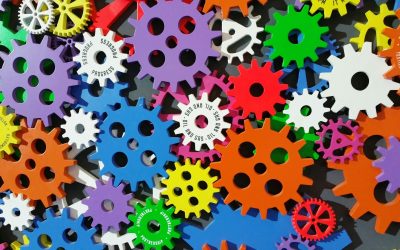In a bulletin last year I wrote about the value of defining an organization’s processes by using a Processing System Hierarchy (Figure 1), which identifies and links “levels” of process, starting with the external environment and then cascading down through the organization’s value chain, primary processing systems, key processes and sub-processes, and finally down to individual performers. In this article I am focusing where the Hierarchy starts.
At this topmost level is what we at the Performance Design Lab (PDL) call the “Super System” view. This view can be applied to any kind of organization or major component (whole corporation, business unit, region, etc.) but for purposes of illustration, let’s call the organization a company with multiple lines of business. Figure 1 shows an example of a Super System map.
The Super-System Map provides a view of two important aspects of any business:
- The external influences, or variables, that exist outside the control of the business but which affect how it operates, including how the organization chooses to view and segment its market.
- The business model by which the organization chooses to interact and provide value to that market and how it makes money in providing that value.
Why should you care about the Super System view? The Super System view reveals the topmost business requirements for the organization system. If defined effectively it should articulate key environmental trends, strategic direction and strategic priorities. The risk of not understanding or validating assumptions about the super system and just jumping to the level at which the need is readily apparent (for instance, at the level of an individual process) creates the potential to make changes that are not in alignment with the needs of the business and that may even unintentionally sub-optimize organization performance.
The first stage of developing a Super System Map is to depict the external situation in which the organization exists and which it must constantly monitor for changes, threats and opportunities. The external components, shown in Figure 2, include:
1. The consumer marketplace
2. The capital marketplace
3. Competition
4. Resources/Supply Chain
5. The general business environment of
a. The economy
b. Governmental constraints/benefits
c. Societal expectations
With this map, on one page you have a picture of a given organization’s critical variables for success or survival. It is also the starting point for identifying changes from outside that must be addressed internally.
Once the external view is depicted, you can drop inside the box labeled “Organization” and complete the picture by depicting the organization’s value chain by which it creates, sells and delivers its products and services. The internal view can also provide a high-level picture of the organization’s organizational design, including major functions, business units or other organizational divisions that collectively must deliver on the organization’s promise to its customers.
The Super System Map constitutes a picture of the company’s business model. In part, the map shows how the company goes to market, how it has structured itself to deliver value to the market, what processes and organizations are leveraged across the lines of business and market segments versus which processes and organizations are unique to a single line of business or product line and how the organization may differ from its competition – in particular where the competitive advantage card is being played. If you add some financial data to the picture – the costs of resources, the costs of transforming inputs into valued goods and services, the prices of those goods and services, and the returns to investors – you also have a view of how the company makes money (or tries to).
Stepping back from the details of a Super-System Map, a few words about why you should care and how PDL uses this tool with clients. As the highest level of the Processing System Hierarchy, the Super-System view is a great starting point for working with executive teams and others to develop an Enterprise Architecture, to formulate or validate an organization’s strategy, to identify, diagnose and improve business process architectures and key processes, to sketch out future-state scenarios and identify the implications on the company’s processes, technologies, people and infrastructure, to help clarify an organization’s business requirements that should drive technology requirements.
And above all, a Super-System Map is visual – it depicts at the enterprise level the great complexities and challenges facing a given business but in a format that virtually anyone can understand.
















